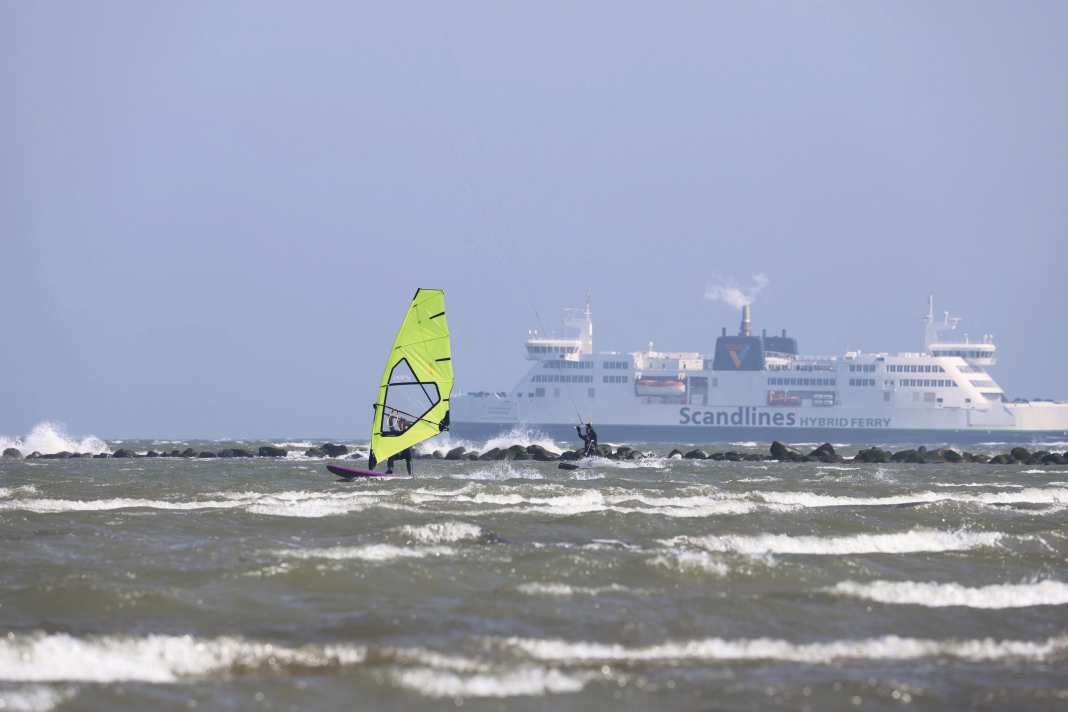





When the plans for the Baltic Sea National Park were presented a few years ago, the hearts of many a tourist, surf school owner or campsite operator on Fehmarn must have dropped. This was because it envisaged large-scale "no-use zones" in which no leisure activities would have been possible.
Just how closely nature conservation on the one hand and tourism on the other meet is immediately apparent along Fehmarn's 78 kilometres of coastline. Visitors to Altenteil, Grüner Brink or Orth are surfing and camping in the immediate vicinity of important nature and bird sanctuaries. Conflicts arise time and again because water sports enthusiasts do not adhere to the rules, which is of course grist to the mill for those in favour of no-go zones. But the truth is that there is hardly any other region on the Baltic Sea that is as economically dependent on water sports as Germany's sunny island.
After emotions ran high at the beginning of the debate in the face of the threat of zero utilisation zones, the storm has now calmed somewhat. Instead of a national park, the "Baltic Sea Protection Action Plan 2030" is now intended to improve the state of the Baltic Sea by placing a total of 12.5 per cent of Schleswig-Holstein's Baltic Sea under strict protection as a compromise solution. The area "west of Fehmarn", which includes the stretch of coast from Altenteil down to Orth, will also be included. For water sports enthusiasts, this at least means that complete, year-round spot closures are off the table for the time being, which should increase acceptance of the undoubtedly necessary protective measures.
In this respect, Fehmarn is likely to remain a mecca for water sports in the future. You can find out what to look out for at the individual spots in our big spot guide.
The best spots for windsurfing on Fehmarn
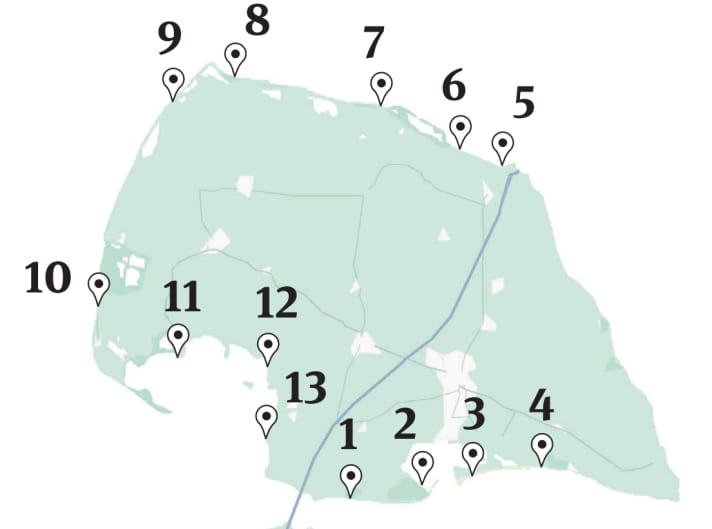
1. miramar
54.4051, 11.1402
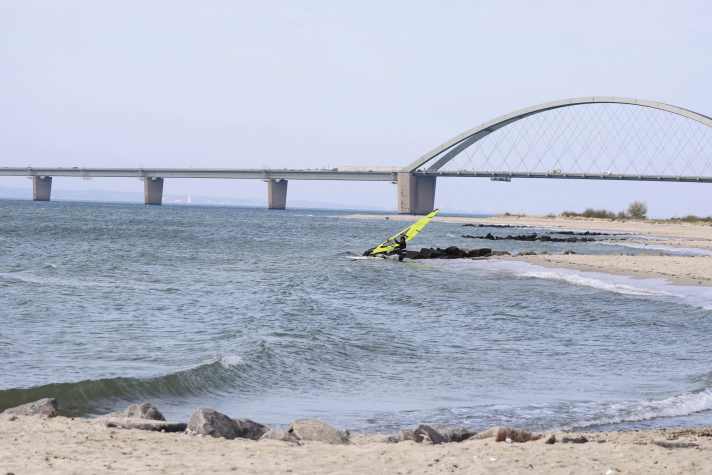
Even if the nearby Wulfen spot is the better alternative if there is enough wind, a detour to Miramar can make sense, as the westerly and easterly winds are amplified here due to the jet effect. Access is either via the campsite or you can park a few hundred metres further west on the Fehmarnsund beach behind the dyke. The groynes are clearly visible and it is easy to get in between them via sand. Both westerly and easterly winds come sideshore, further out there are bump & jump conditions with small chop. The current is sometimes strong here and there is no possibility of landing downwind due to the exposed location. This spot is therefore primarily recommended for experienced windsurfers and not for beginners.

2nd Wulfen
54.4075, 11.1747
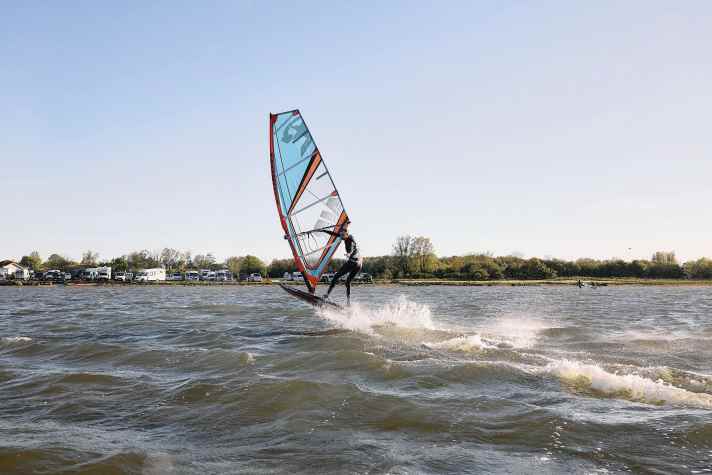
One of the absolute classics on Fehmarn! Separated from the open Baltic Sea by a headland, the shallow Burger Binnensee is a paradise for all skill levels. Whether beginner, manoeuvre fan or freestyle pro - everyone gets their money's worth here. You can park at Wulfener-Hals-Weg on the south-western shore, where there are car parks and a meadow for rigging up. You should still be careful with long fins in the shore area and only press on the tube further out. The spot works best with winds from the northeast to southeast, and easterly winds are also thermally amplified, especially in spring. However, north and north-westerly winds are also good and allow you to make long runs towards the castle. There is also a campsite and a well-stocked surf school on site: Windsurfing Wulfen. There is also a wakeboard facility on site for when the wind is calm. Opposite, towards the south beach, there is another surfing school, Wassersport Charchulla, on Burger Binnensee. However, this spot near the marina is not ideal for free surfing as it is quite small. At best, freestyle sessions in a north-westerly wind are possible here.

3. south beach
54.4108, 11.2031
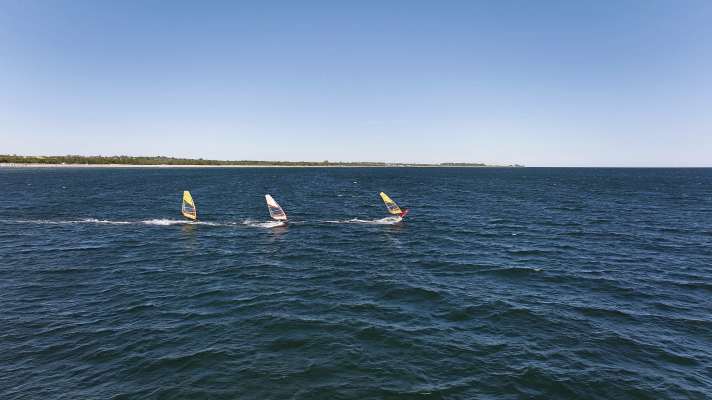
A visit to the south beach can also be worthwhile away from the surf festival on Ascension Day. There are plenty of parking spaces and a beautiful sandy beach to get into the water. There is a small sandbank about 50 metres in front of the beach and, unlike the Burger Binnensee, it quickly gets deep further out, which makes the spot recommended for foiling and heating with long fins. An easterly wind comes in sideshore from the left and, depending on its strength, brings small chop to swell waves that are good for small jumps. With a strong south-easterly wind, a mini swell can sometimes stray onto the sandbank; a south-westerly wind is also good for riding. If the wind shifts further to the west or even north-west, it becomes increasingly gusty here, as the high buildings on the shore then block the wind. What's more, you'll be surfing downwind without a net and double bottom, so it's worth moving to Wulfen, Lemkenhafen or Gold. Not far to the east, at the alternative spot of Meeschendorf, there are three campsites that guarantee short distances to the water.

4. meeschendorf
54.4125, 11.2429
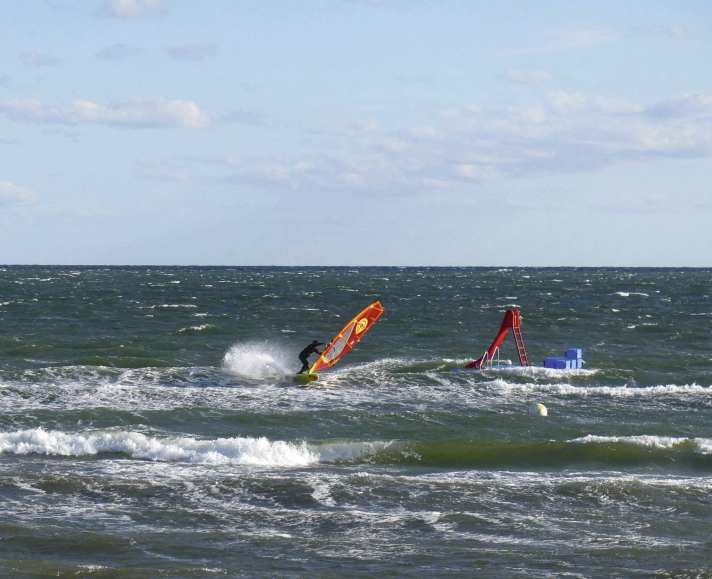
In strong winds from the south-east, Meeschendorf at the south-east end of Fehmarn is a good alternative to Südstrand. There are three possible places for a longer stay on site: Camping Südstrand, Europa Camping and Insel-Camp Fehmarn. Day visitors will also find an additional car park directly on the water's edge in the street Zum Meeresstrand. You can enter the water in Meeschendorf via a narrow strip of sand and between small groynes; there is no larger standing area here. There is a small sandbank just off the shore. Winds from the south-east to east-south-east are ideal at this spot, coming in sideshore to slightly onshore from the left. Because the water is only moderately deep further out, real surf waves are limited to a few stormy days a year. Most of the time there are swell waves and very moderate surf in the area of the sandbank with wave heights of between half a metre and one metre. If the wind shifts more to the east, the south-east tip of the island increasingly blocks the waves. If you are looking for surf waves, you should consider moving to the north coast.

5. Puttgarden-West
54.5038, 11.2172
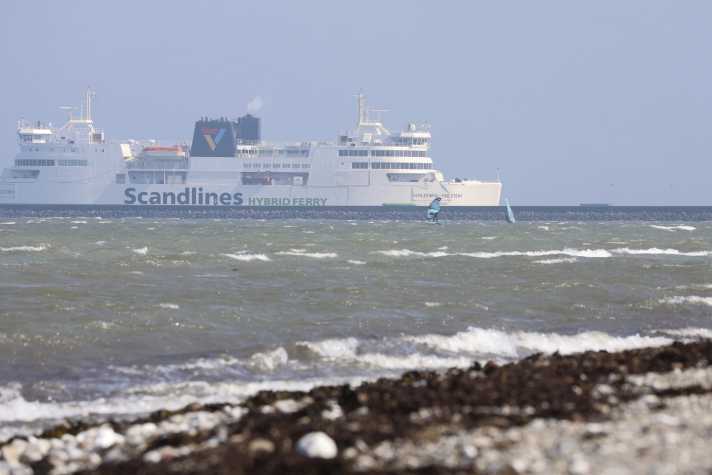
In contrast to the Grüner Brink spot, things are much quieter here - which is definitely an advantage on busy days. You park a few hundred metres downwind of the long pier that borders the ferry harbour to the west. It also gets deep more quickly, which makes things easier with long fins or foils. The spot works particularly well in north-easterly and east-north-easterly winds. It can be a little gusty in the shore area due to the proximity to the ferry harbour, but there is free wind outside. If the wind only blows moderately, bump & jump conditions remain. However, as soon as the wind is blowing at more than 25 knots, there are some nice waves around the pier that break moderately and can be ridden safely even by less experienced wave surfers. You can park at the end of the beach path.

6. green brink
54.5083, 11.1937
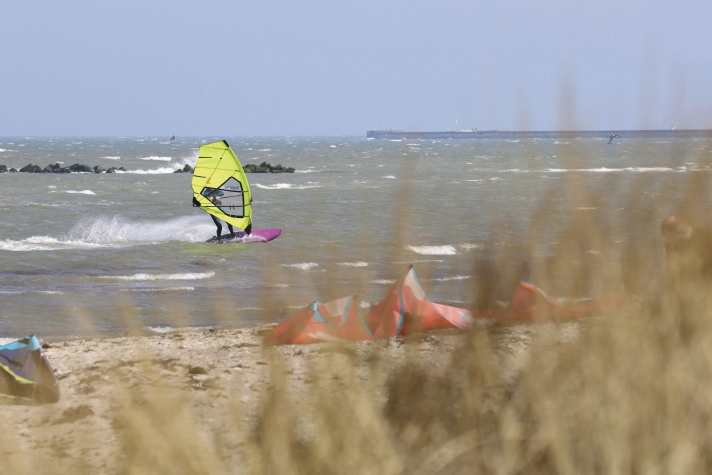
If you head to the north coast of Fehmarn in the direction of Grüner Brink on a windy easterly day, you will find the spot even without a satnav - the numerous kites in the sky, visible from afar, show you the way. You can park behind the dyke, where several car parks are available. Some of these are height-restricted, but there is also an extra space for campers, where you can stay overnight for a fee. From here, a short walk leads over the dyke and across the beautiful sandy beach to the water. The spot is ideal in an easterly wind, which comes in sideonshore from the right. However, because a shallow sandy bay opens up on the left, drifting is virtually impossible. Grüner Brink is a multi-spot that offers different zones: Upwind, a small breakwater blocks the waves, making it easy to get in and get up to speed. Further out, long swell waves come in - ideal for trying your first jumps. In the shallow area further downwind, the waves become steeper and even break moderately - great fun for jumping, backside riding or freestyling! The angle is not ideal for front side riding because the wave runs almost in the direction of the wind. Nevertheless, the spot is like a large N playground where everyone can have fun. North-westerly winds also work, but Altenteil is definitely better! The only thing you shouldn't have here is an aversion to kites. There are catering facilities and a playground on the dyke - so the rest of the family can also easily spend a nice day on the beach here.

7th Niobe
54.5216, 11.1539
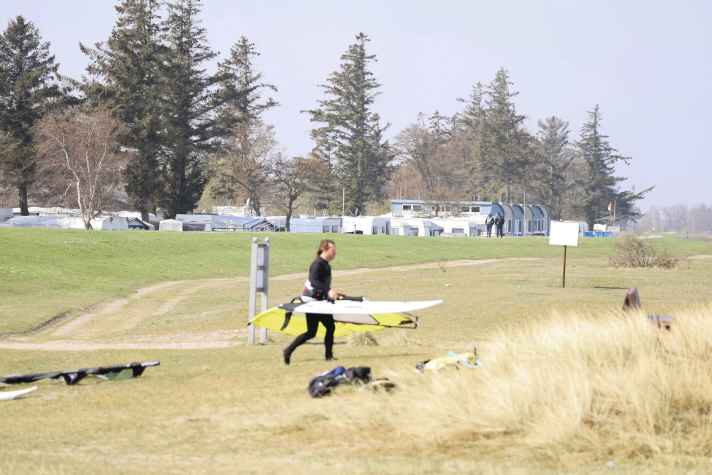
Niobe is always somewhat overshadowed by Altenteil and Grüner Brink, but is definitely worth a visit. While at Grüner Brink you sometimes can't see the sun because of all the kites, a few kilometres to the west it is almost tranquil. Directly behind the natural beach and the dyke, there is a large car park, a pitch for camper vans and a campsite. You can rig up on grass, the beach itself is sandy with a few stones. Niobe is ideal in easterly to east-north-easterly winds, when the wind blows almost sideshore from the right. Because the beach slopes a little steeper, some shore break can form in strong winds. After that, it is immediately deep enough for longer fins and foils. The conditions on site are the definition of bump & jump: swell waves come in, which only break sporadically and extremely gently over the offshore sandbanks in moderate winds. The spot only takes on a surfy character during storms, when the shore break can become challenging. Only during the summer season is there a bathing area in the right-hand part of the bay, surfing is then to the left (west) of it.
With strong winds from the west-north-west to north-west, Niobe is a veritable wave spot and a nice alternative to Altenteil, although the waves don't break quite as cleanly. As soon as Altenteil is overcrowded, however, it is worth a detour.

8. retirement home
54.5306, 11.0823
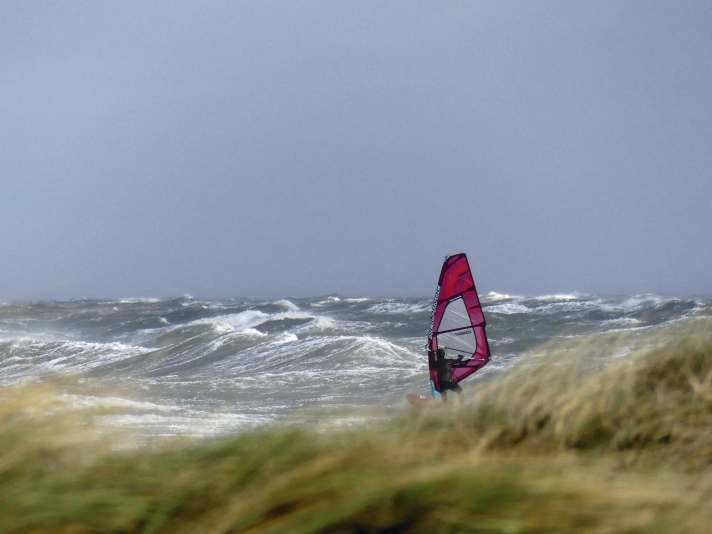
The wave pearl of the Baltic Sea island is undoubtedly Altenteil. To get the spot going, you need a strong wind from the west-north-west to north-west. The wave is then sorted by a headland upwind and runs cleanly into the bay. You can park in the car park at Belt-Camping Fehmarn or at the end of the road directly in front of the entrance to Ahoi Camp. The entrance is via the beautiful natural beach, there are also some stones in the water and in strong winds some shorebreak can make the start difficult. Under 30 knots of wind, however, Altenteil is not a particularly difficult spot to surf. Once you have left the small shore break behind you, you can take a run-up and spiral into the air over a ramp. The spot is also very suitable for frontside rides, with several turns to leeward possible, although the waves over the sandbank - apart from stormy days - rarely break really powerfully. Due to the exposed location, the current is noticeable, so if in doubt, it is better to rig one sail size larger! Altenteil presents a different picture with an easterly wind. This comes in sideshore from the right and offers bump & jump conditions, with only a few small surf waves occasionally straying into the bay.

9 Westermarkelsdorf
54.5228, 11.0477
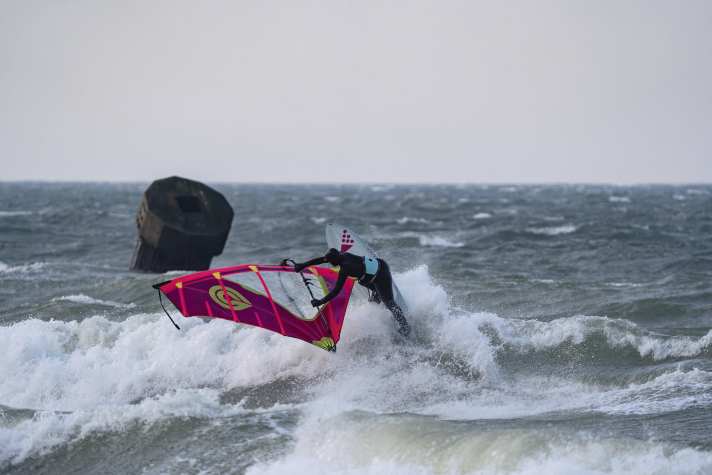
If you are looking for waves in westerly winds on Fehmarn, you have to go to the west coast. One of the well-known spots is Westermarkelsdorf. Here, too, there are rocks in the entry area and in strong winds there is a shorebreak and a noticeable current, which can make life difficult not only for wave novices. Wind from the south-west arrives almost sideshore from the left, but usually only brings small waves that break at short intervals and close to the beach. If the wind shifts to the west-south-west or even west, the breakers get bigger, but the conditions become increasingly challenging in onshore conditions. In westerly gales, waves of up to two metres are possible - if it's too wild here, you should move to the mainland in Heiligenhafen. About 100 metres out lies an old concrete block in the water. Jokingly referred to as the "Baltic Sea plug", the obstacle is clearly visible. From 1935 to 1942, the ten-sided concrete pillar served as a water level and warning marker, after which the block was pushed aside by pack ice and taken out of service. Car park and toilets at the spot.

10th Püttsee
54.4650, 11.0098
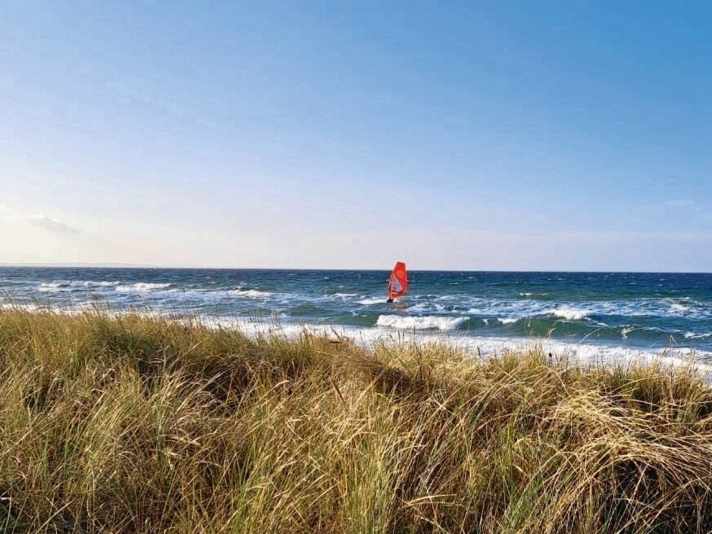
Püttsee is located to the south of Westermarkelsdorf and can be an alternative to Westermarkelsdorf due to its stronger north-south orientation in south-westerly wind directions. Simply let the sat nav navigate you to the "Püttsee beach car park", which is located directly behind the beach. The spot is already rideable in south-south-westerly winds, although you shouldn't expect any big waves then - the surf is usually knee to waist-high and breaks over the sandbank in front. If the wind shifts to the south-west, slightly higher sets are also possible, but Westermarkelsdorf is usually blessed with higher surf waves. However, you shouldn't drop off from the starting point, as the Wallnau nature reserve not far to the north is a no-go zone for surfers. The entrance here is also largely sandy with a few stones, and a small shorebreak can also occur if the wind is strong enough. If it is crowded here, you can alternatively head for Bojendorf, where there are comparable conditions.

11th Orth
54.4488, 11.0506
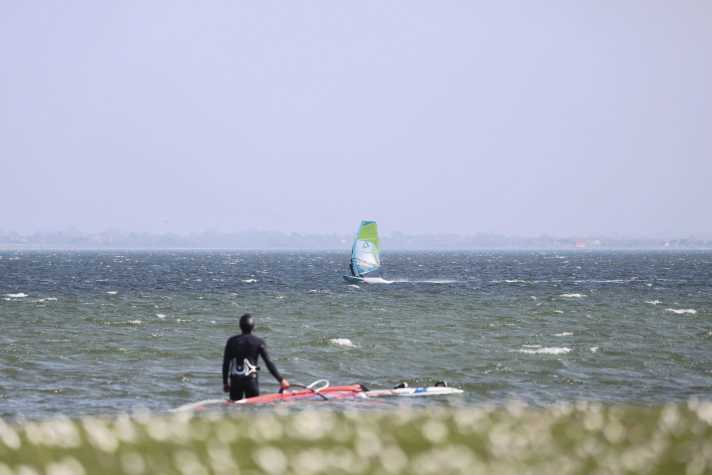
Orth is one of Fehmarn's best-known spots and is located in the south-west, within sight of the Flügge lighthouse. The small harbour with its piers divides the spot, and you can park in the day car park "An Diek". Around the harbour there are also toilets, some restaurants and the well-stocked Windsurfing Fehmarn water sports school. Depending on the wind direction, you walk about 200 metres from the car park to the appropriate side. If the wind is blowing from the north-east, east or south-east, the eastern bay is the first choice. Here, you will be jibing on a nice meadow, with the wind coming onshore, making it impossible to drift off. There is also a 150 metre wide standing area along the shore - so you can always board parallel to the coast in shallow water. Further out, the water gets deeper, making the spot ideal for slalom racing and foiling.
In westerly winds, similar conditions can be found on the other side of the harbour. A narrow, offshore headland blocks the waves so that even in strong winds there are only small chops - ideal for heating up, practising manoeuvres or freestyling. You shouldn't go too far out in westerly winds, as the offshore headland is part of the Krummsteert nature reserve and is off-limits to water sports enthusiasts.

12th Lemkenhafen
54.4430, 11.0984
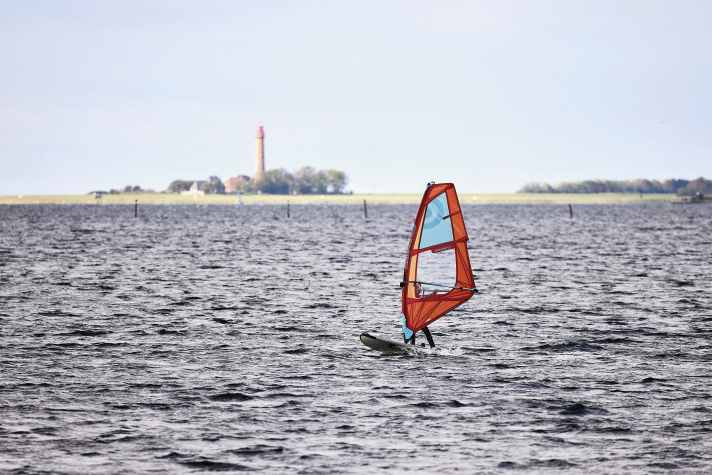
What Wulfen is to an easterly wind, Lemkenhafen is to a westerly wind: probably the most popular spot on the island. From west-north-west to south-south-west, all wind directions arrive freely and consistently at the spot. In addition, the islets and headlands off the coast consistently block the waves, which means that there are no big waves here even during storms. To round things off, Lemkenhafen scores with a very large standing area where you can surf in complete safety, and drifting downwind is not possible anyway. The most popular entry point in westerly winds is the "car park on the flat beach". Westerly winds come fully onshore here, you enter over sand and a few stones. With longer fins, you have to run out a little to get enough water depth, as the entire bay is between knee and waist deep. In summer, seaweed can collect here, but you should have a suitable fin with you at all spots anyway. Alternatively, you can also enter the water at the entrance to the sailing harbour, which is popular with kiters, and there is also a car park right next to the spot.
The small village also has a snack bar, fish stall etc. The water sports school at the school hostel is currently closed - according to the website (surfspot-fehmarn.de) but only temporarily. There's an alternative in town with Boardflash.

13th Gold/Strukkamp
54.4242, 11.1004
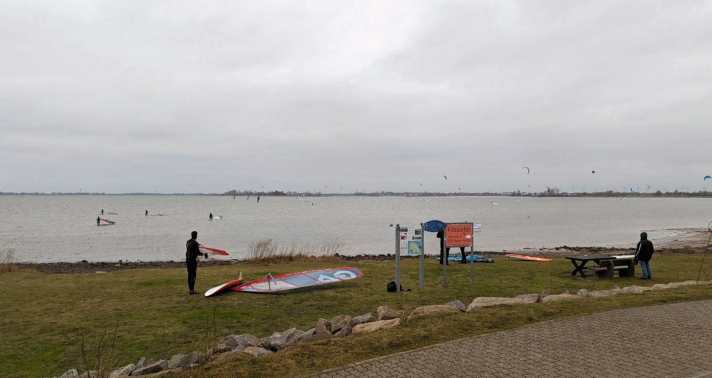
With a similar setup to Lemkenhafen, Gold can also shine, which is why this top spot is so popular. You park not far from the water's edge, from there it is only 100 metres to the beach. The journey is worthwhile in westerly winds, from south to west to north-north-west, everything is easily navigable. In westerly to north-westerly winds, the headland two kilometres to windward blocks larger waves. But even in south-westerly winds, only short, steep chops get lost on the coast, as the water is no deeper than 1.5 metres over a large area. This makes Gold an ideal spot to safely hone your water start, perform speed runs or raise your freestyle level. You just have to watch out for the groyne to the left of the entrance, but it is visible. Kiters are traditionally found further to the right, with windsurfers increasingly on the left. Because Gold is also perfect for beginners and intermediates, there is a well-stocked water sports centre on site, Tim's Beach, where you can take courses or hire equipment. There are also toilets and Café Achterndiek at the spot - what more could a surfer's heart want?
Alternatively, not far to the south, in Strukkamp, you will find almost identical spot conditions, also with a large standing area. However, day visitors park further away from the water here and have to carry their equipment to the water via the campsite. However, if you want to stay on site for longer, you can rent a spot directly at the local campsite. A surf school and beach bar round things off - this is the place to be!

Spot info Fehmarn
Arrival
Whitecaps everywhere, sunshine and colourful sails on the water - now all you have to do is quickly cross the bridge and ... you're stuck in a traffic jam. If you can avoid the rush hour to cross the Fehmarnsund Bridge, you should. Apart from that, Fehmarn is well connected via the A1 motorway. And maybe even via a tunnel at some point. On Fehmarn itself, the clocks tick a little slower, which is mainly due to the fact that the sometimes narrow country roads and through-town roads are not made for XL motorhomes.
Wind, weather & waves
There is no wind direction that is not surfable on Fehmarn. However, westerly or easterly winds are the most common. With winds from the south-west to west, it can get chilly even in the height of summer. Between June and September, a 4/3 neo is usually sufficient. In spring and autumn, a thick skin and a bonnet should be in your luggage.
The pronounced easterly winds that often occur in spring and early summer and sometimes provide great conditions for many days in a row are fantastic on Fehmarn. In spring, however, the air is much colder than on the mainland due to the still cool Baltic Sea, and it is not uncommon to leave home in a T-shirt at 25 degrees and frantically search for a jacket on Fehmarn in 15 degrees and a strong wind. On the other hand, easterly winds are significantly stronger, especially in spring - a 12-knot forecast on Windfinder can quickly turn into a day with 20 knots plus X. All in all, Fehmarn has a very good wind ratio of around 40 per cent gliding wind in summer and up to 65 per cent in the winter months.
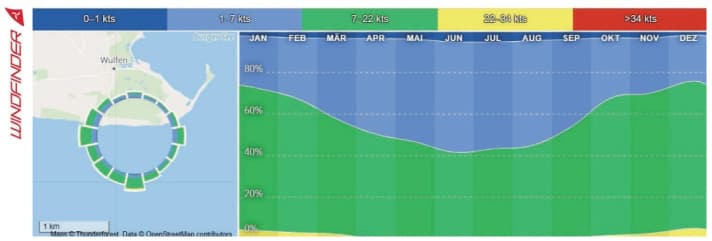
Although the island is very exposed, the wave heights often remain moderate, which is why avowed wave fans usually switch to spots in Hohwachter or Lübeck Bay. The best waves can be found in westerly and north-westerly winds - even if this is surprising when you look at the map. Due to the shallow water depths, the easterly wind spots often only have knee- to chest-high waves. More on this in the individual descriptions of the spots.
Living & Camping
Fehmarn is very well developed for tourism, there is accommodation in all price categories and numerous campsites, some of which are very close to the spot. Here is a selection:
Miramar
Wulfen
South beach/Meeschendorf
Puttgarden
Niobe
Altenteil
Püttsee
Orth
Gold/Strukkamp
Surf schools
The surf schools are mainly located in the large standing areas, where you can book courses and hire equipment:
Wulfen
South beach
Meeschendorf
Orth
Lemkenhafen
Gold
Strukkamp
Surf shops
There are two very well-stocked surf shops on Fehmarn with a wide range of hardware and accessories. You can also test equipment here before you buy.
- Windsport Fehmarn windsport.de
- Surfshop Fehmarn surfshopfehmarn.de
Good to know
Several nature reserves are located in the immediate vicinity of the surf spots. Information boards explain the conditions. Please observe the no-go zones! Seaweed is an issue at almost all spots, between May and November you should always bring appropriate fins with you.
Alternative programme
Marine centre, submarine museum, wakeboarding facility - Fehmarn doesn't get boring even when it's calm.

